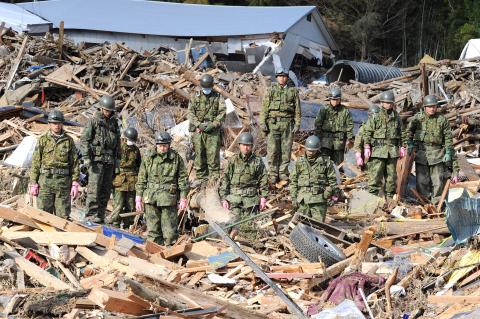|
ˇ@
Japan mulls burying nuclear plant
HELL OF A WEEK:Officials yesterday raised the incident
level at Japanˇ¦s crippled nuclear plant to five on the INES scale, which ranks
nuclear accidents on a one to seven scale
Reuters, TOKYO

Soldiers observe a minute of silence in
Minamisanriku, Miyagi Prefecture, Japan, yesterday. Japan is battling a nuclear
and humanitarian crisis as engineers work to restore power to a stricken atomic
plant, while the toll of dead and missing from the quake and tsunami topped
16,000.
Photo: AFP
Japanese engineers said yesterday that burying a crippled nuclear plant in sand
and concrete may be a last resort to prevent a catastrophic radiation release.
The same method was used to seal huge leakages from Chernobyl in 1986.
However, they still hoped to solve the crisis by fixing a power cable to two
reactors by today to restart water pumps needed to cool overheating nuclear fuel
rods. Workers also sprayed water on the No. 3 reactor, the most critical of the
plantˇ¦s six reactors.
It was the first time the facility operator had acknowledged burying the
sprawling complex was possible, a sign that piecemeal actions such as dumping
water from military helicopters or scrambling to restart cooling pumps may not
work.
ˇ§It is not impossible to encase the reactors in concrete, but our priority right
now is to try and cool them down first,ˇ¨ an official from the plant operator,
Tokyo Electric Power Co, told a news conference.
As Japan entered its second week after a magnitude 9.0 earthquake and 10m
tsunami flattened coastal cities and killed thousands of people, the worldˇ¦s
worst nuclear crisis since Chernobyl looked far from over.
The nuclear disaster has triggered global alarm and reviews of safety at atomic
power plants around the world.
ˇ§This is something that will take some time to work through, possibly weeks, as
you eventually remove the majority of the heat from the reactors and then the
spent-fuel pools,ˇ¨ US Nuclear Regulatory Commission chairman Gregory Jaczko told
a news conference at the White House.
Millions of people in Tokyo continued to work from home, some fearing a blast of
radioactive material from the complex 240km to the north, although the
International Atomic Energy Agency said radiation levels in the capital were not
harmful.
That is little solace for about 300 nuclear plant workers toiling in the
radioactive wreckage. They are wearing masks, goggles and protective suits, the
seams of which are sealed off with duct tape to prevent radioactive particles
from creeping in.
ˇ§My eyes well with tears at the thought of the work they are doing,ˇ¨ Kazuya
Aoki, a safety official at Japanˇ¦s Nuclear and Industrial Safety Agency said.
Even if engineers restore power at the plant, the pumps may be too damaged from
the earthquake, tsunami or subsequent explosions to work. The first step is to
restore electricity to pumps for reactors No. 1 and No. 2 by today.
By tomorrow, the government expects cooling pumps for badly damaged reactors No.
3 and No. 4 to have power, Japanˇ¦s nuclear agency spokesman Hidehiko Nishiyama
said.
Asked about burying the reactors in sand and concrete, he said: ˇ§That solution
is in the back of our minds, but we are focused on cooling the reactors down.ˇ¨
Some experts said dumping water from helicopters to try to cool spent-fuel pools
would have little impact.
ˇ§One can put out forest fires like this ˇX by pouring water from far above, said
Russian nuclear expert Gennady Pshakin. ˇ§It is not clear where this water is
falling. There is no control.ˇ¨
Japan raised the incident level at the crippled plant to five on a scale called
INES to rank nuclear accidents, up from four, on a one to seven scale.
That puts it on a par with the Three Mile Island accident in the US in 1979,
although some experts say it is more serious. Chernobyl was a seven on the INES
scale.
The plight of hundreds of thousands left homeless by the earthquake and tsunami
worsened following a cold snap that brought heavy snow to worst-affected areas.
Supplies of water, heating oil and fuel are low at evacuation centers, where
many survivors wait bundled in blankets. Many elderly lack proper medical
supplies. Food is often rationed.
The government said yesterday it was considering moving some of the hundreds of
thousands of evacuees to parts of the country unscathed by the devastation.
Nearly 320,000 households in the north were still without electricity in
near-freezing weather yesterday afternoon, Tohuku Electric Power Co said, and
the government said at least 1.6 million households lacked running water.
The National Police Agency said yesterday it had confirmed 6,539 deaths from the
quake and tsunami, exceeding the 6,434 who died after the Kobe earthquake in
1995, but 10,354 people are still missing.
The government has told everyone living within 20km of the plant to evacuate and
advised people within 30km to stay indoors.
The US embassy in Tokyo has urged citizens living within 80km of the Fukushima
Dai-ichi plant to evacuate or remain indoors ˇ§as a precaution,ˇ¨ while Britainˇ¦s
foreign office urged citizens ˇ§to consider leaving the area.ˇ¨
ˇ@
|
![]()
![]()
![]()